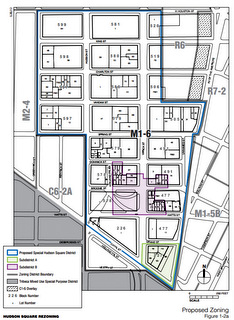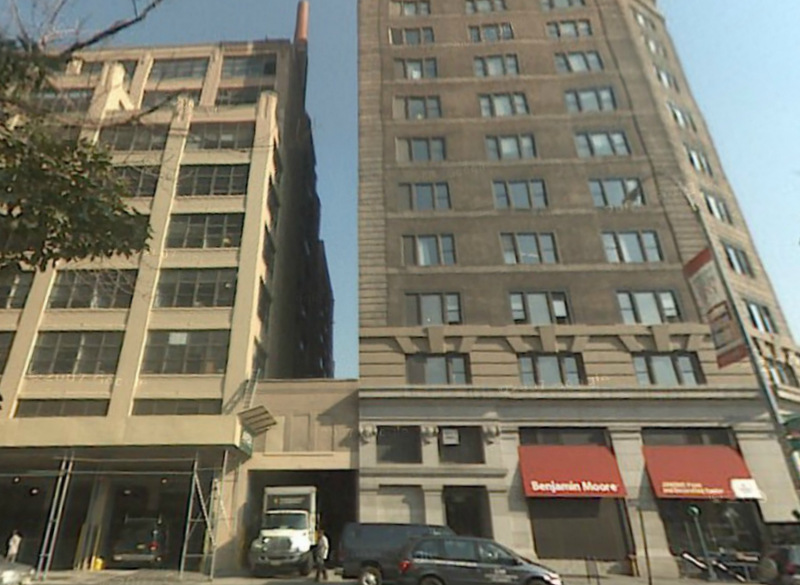
Map of proposed Special Hudson Square district. Subdistrict B was eliminated from the proposal. Image Courtesy: DCP.
Trinity Church committed $5.6 million contribution for Dapolito Recreation Center renovations but open space issues remain at City Council. On January 23, 2013, the City Planning Commission approved Trinity Church’s application to create the Special Hudson Square District. The purpose of the Special District is to maintain commercial office space – mainly occupied by creative industries – that has made the Hudson Square neighborhood distinct while encouraging mixed-use development and a vibrant community. The proposal would retain the area’s M1-6 zoning, which permits only commercial, manufacturing and limited community facility uses, but would add and modify zoning regulations aimed to allow residential and increased community facility uses. The area is generally bounded by West Houston and Canal Streets, Avenue of the Americas, and Greenwich Street. Trinity Church owns approximately 39 percent of the lots within the 18-block proposed Special District. (See CityLand’s past coverage here).
The area’s M1-6 zoning currently does not provide building height limits and setbacks, which has led to out-of-character development in more recent years. The Special District would establish height limits of 185 feet on narrow streets and 320 feet on wide streets as well as setback regulations. The maximum floor area ratio would be 10.0 for non-residential uses and 9.0 for residential uses, with a possibility of 12.0 for participation in the City’s Inclusionary Housing Program. The proposal expects approximately 3,000 new residential units will be added to the Special District as a result of the rezoning.
The proposal would also establish protective provisions to prevent the conversion of existing commercial space. Conversion of existing commercial or manufacturing buildings with at least 70,000 sq.ft. of floor area to either hotel use (100-plus rooms) or residential use must retain the same amount of commercial or manufacturing floor area. For hotel conversions, the replacement floor area can be within the same building or elsewhere in the Special District and must be accomplished through a special permit. The special permit requirement expires when 75 percent of the projected residential units are developed.
Residential conversion of existing commercial or manufacturing buildings would require that non-residential floor area be replaced on the same zoning lot. Provisions for ground floor retail and transparency were also tailored to encourage an active streetscape on evenings and weekends.
The proposal would create two subdistricts. Subdistrict A would accommodate Trinity Church’s future development plans for a mixed-use building with a 444-seat public school. Subdistrict A is bounded by Avenue of the Americas, Grand, Canal, and Varick Streets. Subdistrict B would set lower FAR and building heights than the rest of the Special District in order to discourage demolition of the existing rowhouses in an area that includes portions of Dominick, Broome, Watts, and Varick Streets, and part of the Holland Tunnel entrance.
Manhattan Community Board 2 voted unanimously to disapprove the application unless certain conditions were met. The main concern of the Community Board was the Trinity Church’s failure to encourage or propose open space options. With the neighborhood’s population expected to rise with the rezoning, the Community Board was concerned that the area lacks an adequate amount of open space to accommodate new residents. Additionally, the Community Board requested the elimination of Subdistrict B because it did not believe the proposed regulations would successfully preserve the area.
Manhattan Borough President Scott M. Stringer recommended conditional approval of the application and asked for a height reduction on wide streets, elimination of Subdistrict B, and the facilitation of open space.
At City Planning’s hearing on November 28, 2012, many local residents and property owners generally praised the proposal, hoping new retail and residential establishment would enliven the area on evenings and weekends. Local elected officials, the Community Board, and neighborhood residents raised concerns about Subdistrict B and open space. The Community Board and local residents called for Trinity Church to build a new community facility within the mixed-use development in Subdistrict A. Trinity Church contended that a new recreation facility was economically infeasible but committed to find existing open space areas for improvement.
The Community Board and the Borough President reiterated their concerns over wide street building heights, suggesting between 250 to 290 feet. Some local property owners suggested raising building heights for midblock buildings on narrow streets to 210 feet or higher. Those owners stated that the proposed maximum height of 185 feet will restrict developers from achieving the maximum floor area ratio available under the City’s Inclusionary Housing Program, which would result in less overall affordable housing in the area.

View of 233 Spring Street (left) and 161 Avenue of the Americas (right) buildings. A core building is proposed to replace the middle one-story loading dock. Credit: Google maps.
Nick Hockens, of Greenberg Traurig, who represented the owner of properties at 233 Spring Street and 161 Avenue of the Americas, requested grandfathering development plans currently awaiting a Department of Buildings permit. The two buildings are currently separated by a one-story, 19-foot wide loading dock on Spring Street. The owner seeks to modernize and enlarge the existing office and ground floor retail space as well as build a 15-story core building to replace the loading dock. The core building would eventually provide a shared lobby and elevator core for the Spring Street and Avenue of the Americas buildings. The project complies with the current zoning regulations, but would not comply with the rezoning proposal’s street wall requirements. Under the proposed rezoning, the core building’s street wall would have to match the street line up to a minimum base height of 125 feet. The proposed core building’s design calls for a recessed street wall deeper than the street lines of the buildings, which are at differing depths. Hockens argued that the result under the proposed rezoning would be a less efficient building design with less continuity between all of the buildings.
On January 23, 2013, the City Planning Commission approved the rezoning with modifications. The Commission eliminated Subdistrict B from the proposal because it would have placed unnecessary density and bulk controls on the designated area. The Commission reduced the maximum building height on wide streets from 320 to 290 feet, while increasing the maximum width from 150 to 175 feet, as long as the street wall has at least a five-foot recess above 150 feet. This change was believed to be more in context with the area’s buildings. The Commission added a special permit provision to allow midblock sites on narrow streets to modify height (up to 210 feet) and setback regulations. The Commission also added a provision to grandfather the development project at 233 Spring Street and 161 Avenue of the Americas.
Trinity Church executed a restrictive declaration stating that when it seeks building permits that would result in the Special District exceeding 60 percent of the proposed residential units (1,062 units), the applicant will provide $5.6 million to the City’s Department of Parks and Recreation for improvement of existing open space. Improvement priority will be given to the Tony Dapolito Recreation Center at Clarkson Street and 7th Avenue South, because of its proximity to the Special District and its capacity to accept new membership. Tony Dapolito was a legendary community advocate for parks in Greenwich Village and served on Community Board 2 for 52 years until his death in 2003. The improvements proposed are central air conditioning, a larger main gymnasium, upgrades to the indoor track, and an increase of fitness rooms. The Dapolito Recreation Center will undergo structural improvements by Parks, but if improvements to the Center become impracticable in the future, Parks will consult with both the Community Board and the local council member for alternative open space improvement options.
Commissioner Michelle de la Uz voted “no” on the proposal, citing the proposal’s failure to raise the maximum height of buildings on midblock, narrow street sites to 210 feet to encourage use of the City’s Inclusionary Housing Program.
The application was heard at City Council’s Zoning & Franchises Subcommittee hearing on February, 12, 2013. The main issues presented during testimony involved open space, midblock heights on narrow streets, and the landmarking of the South Village neighborhood.
CPC: Special Hudson Square Rezoning and Text Amendment (C 120380 ZMM – rezoning); (N 120381(A) ZRM – text amendment) (January 23, 2013).
Read CityLand‘s in-depth coverage of the City Council hearing here.

